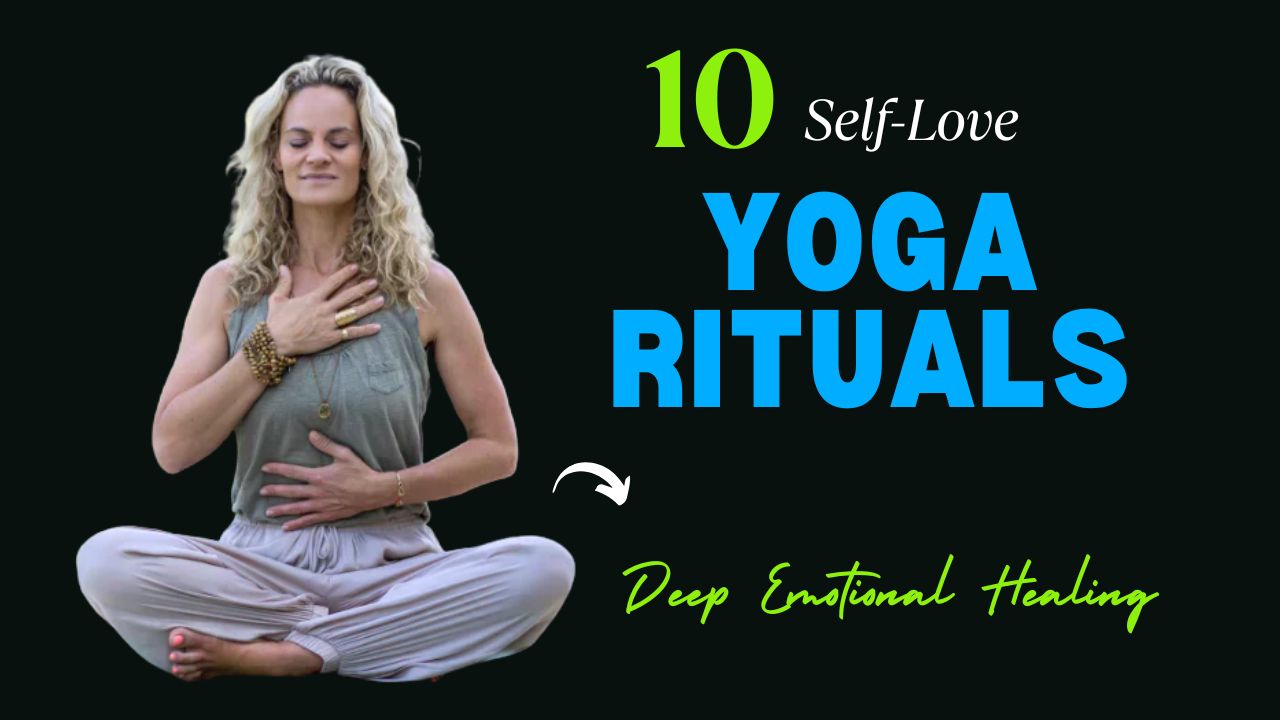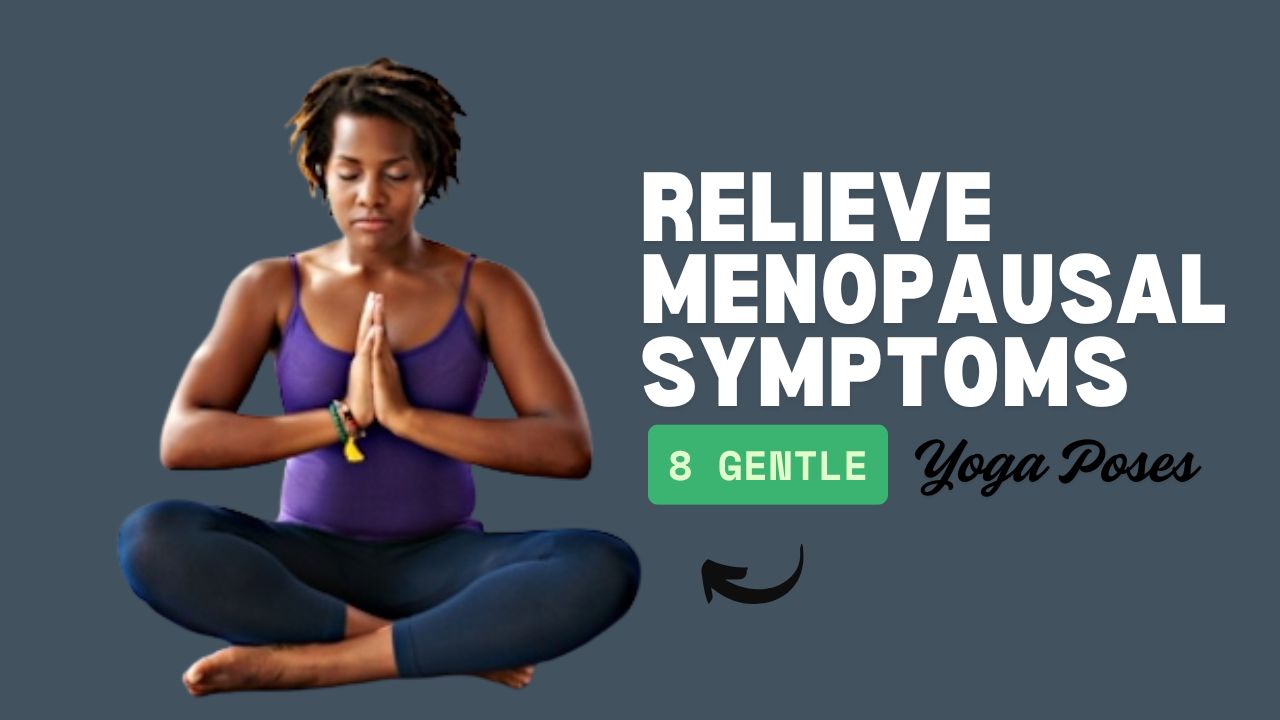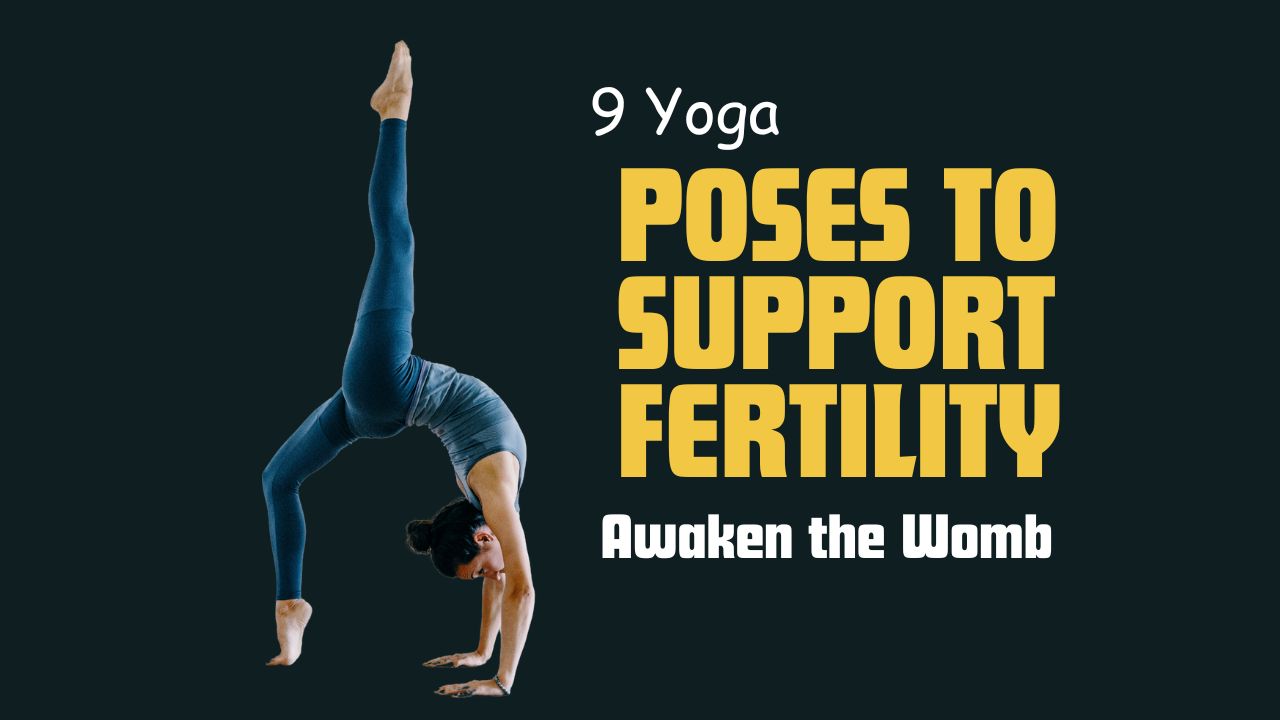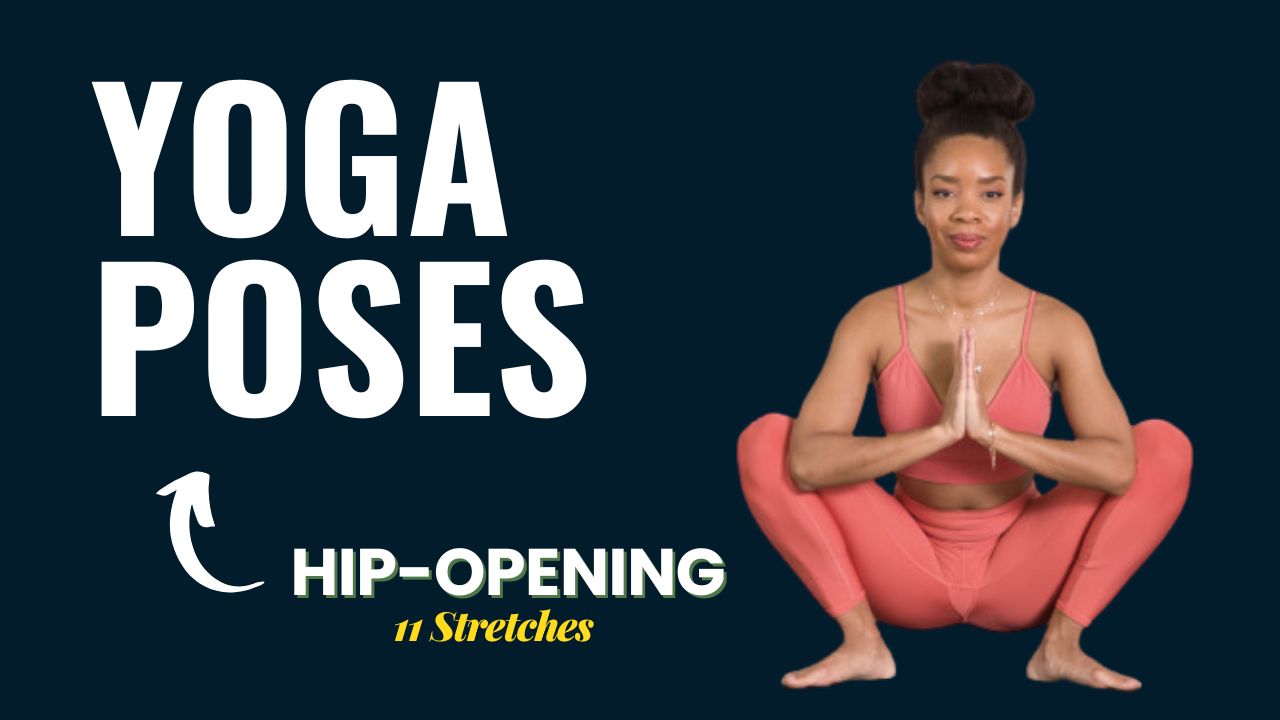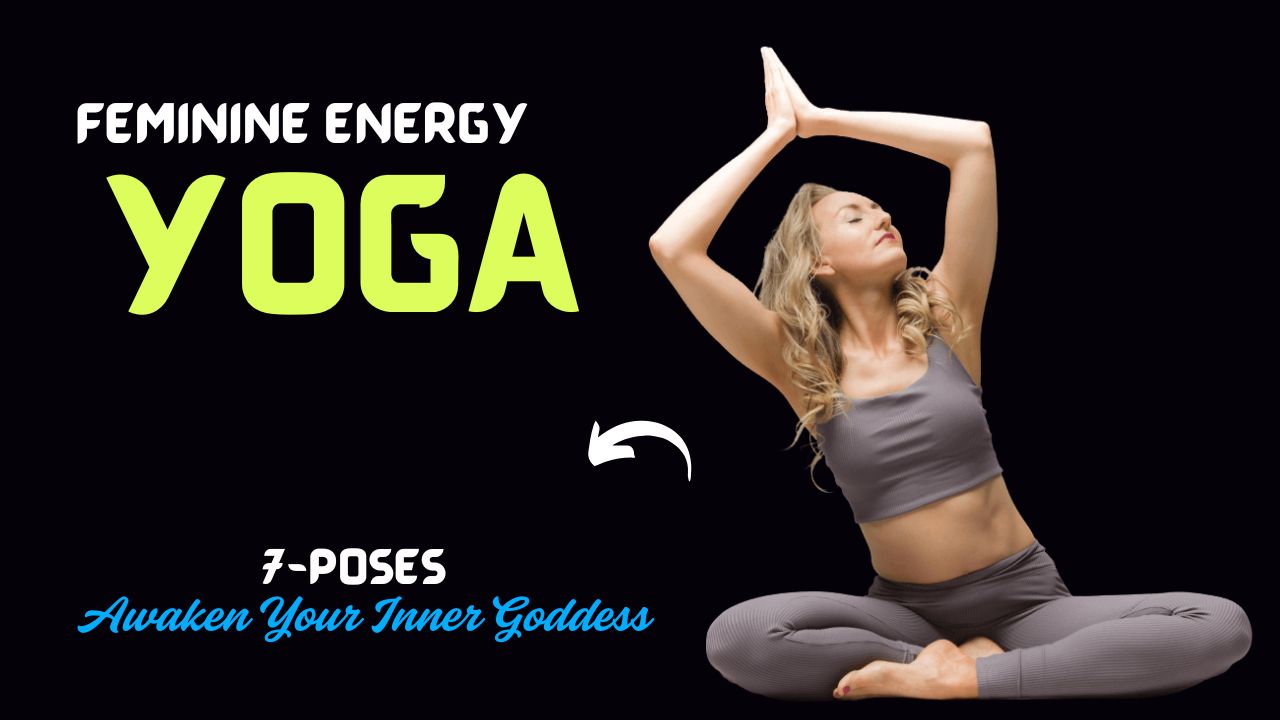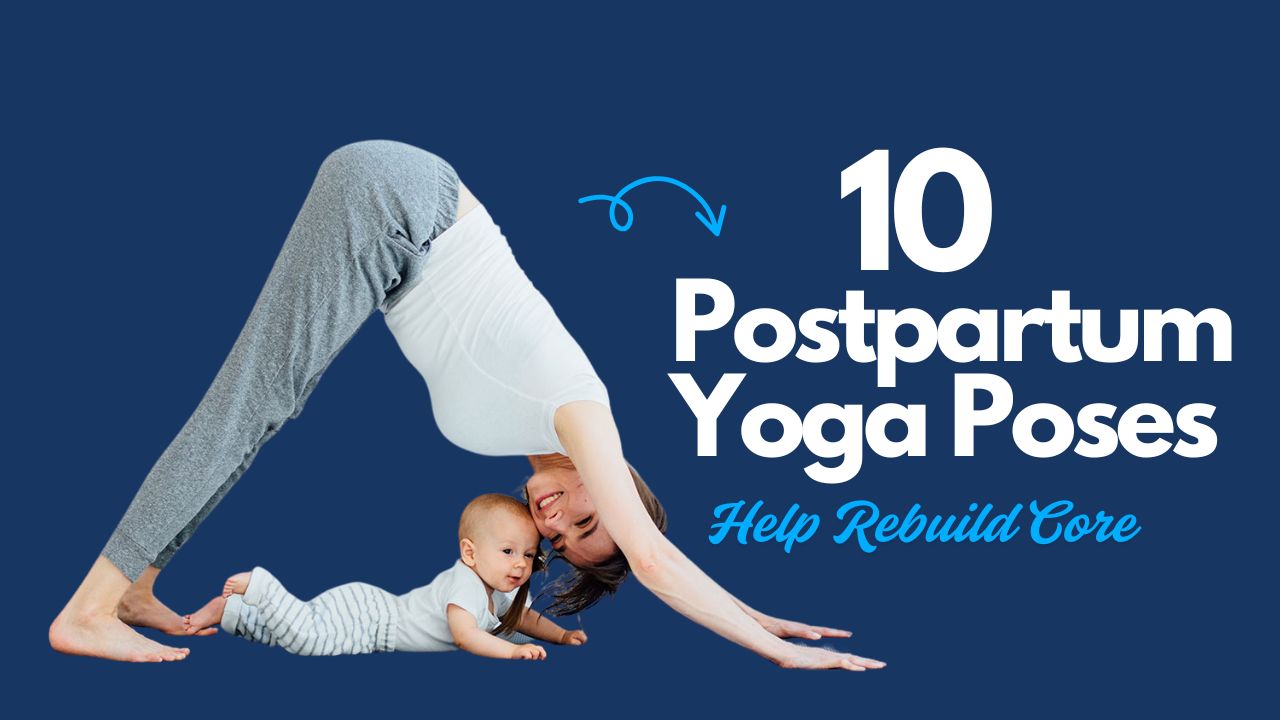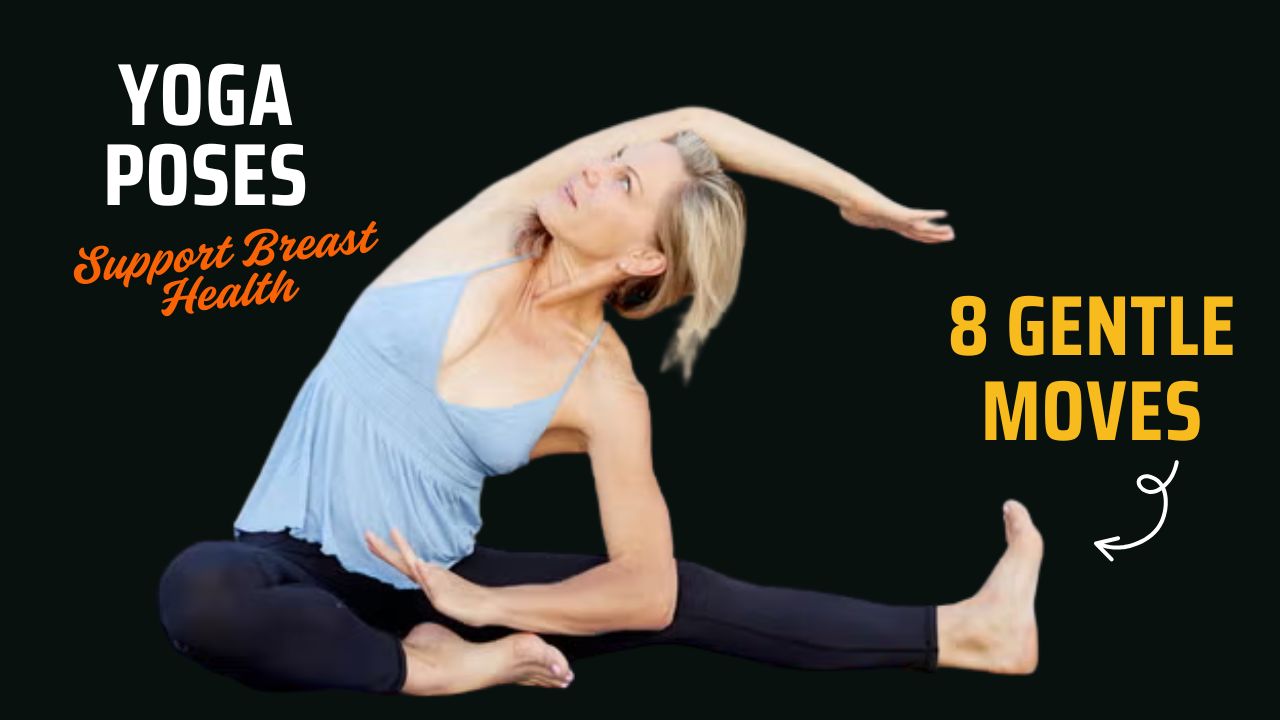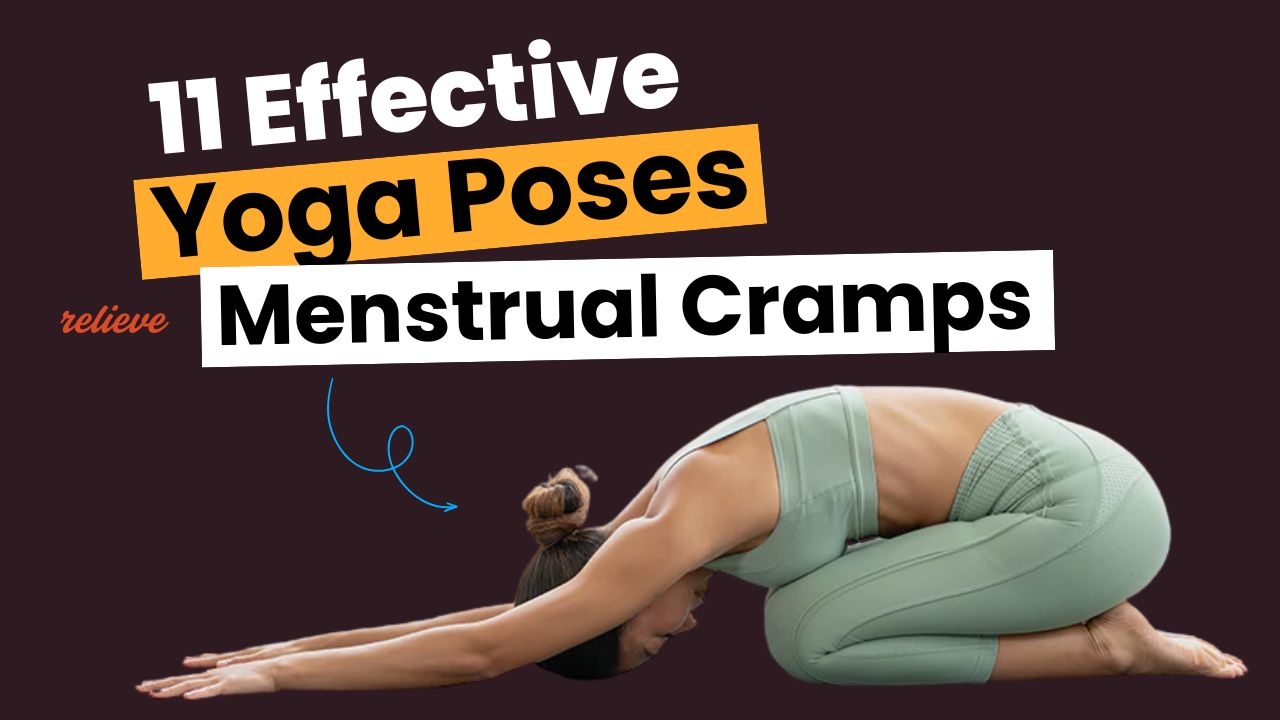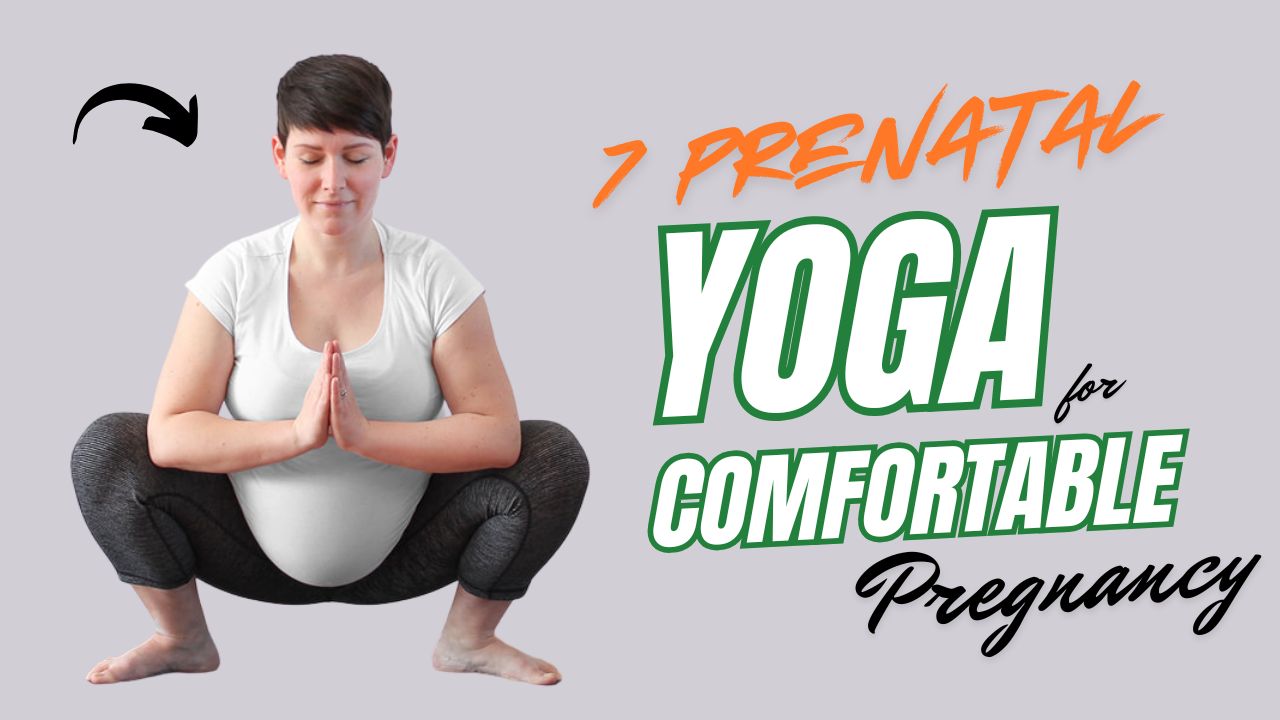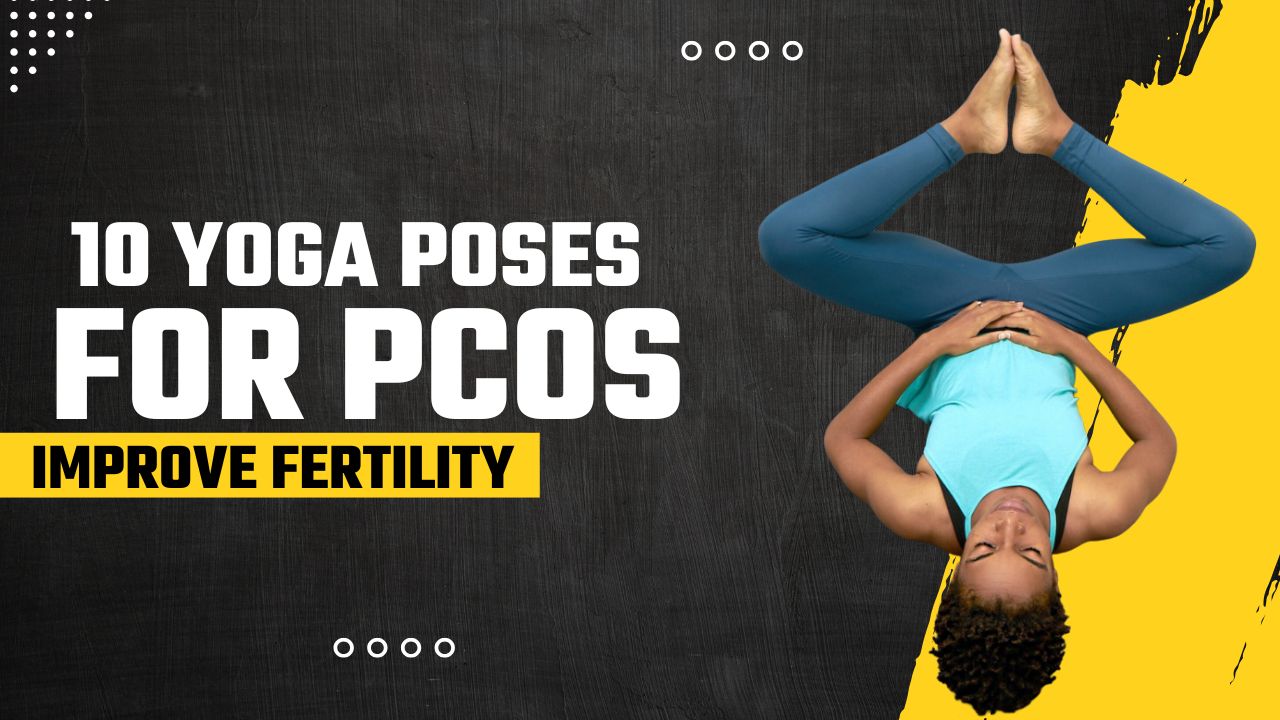Most women experience menstrual cramps at some point in their lives, yet few know that gentle yoga can be more effective than over-the-counter painkillers in easing that monthly discomfort.
Surprising? Science backs it up — certain yoga poses can calm the nervous system, reduce pelvic tension, and improve circulation to ease cramping.
Let’s explore 11 highly effective yoga poses you can safely do at home to relieve menstrual cramps, one breath at a time.
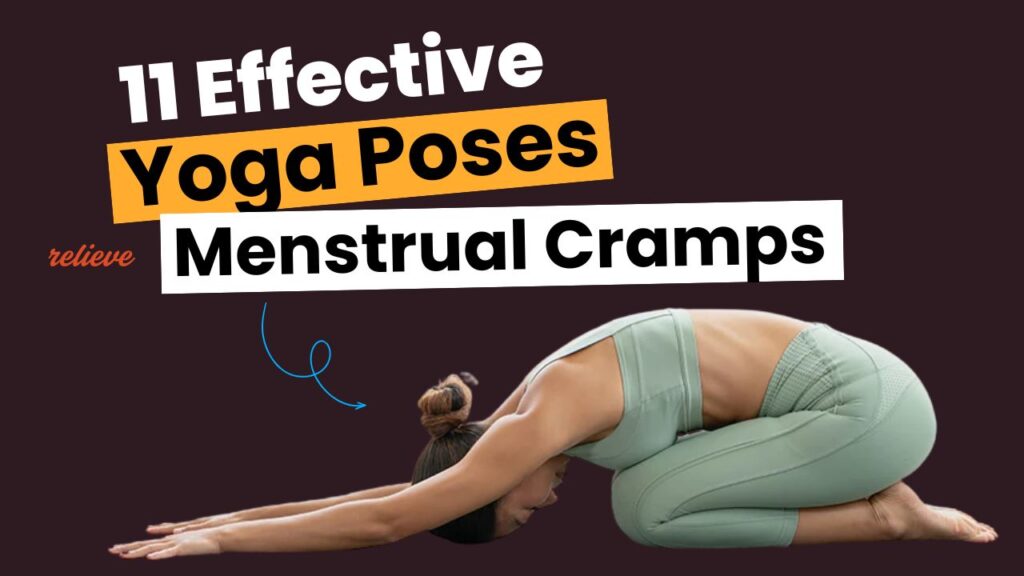
Table of Contents
Why Yoga for Menstrual Cramps?
Menstrual cramps, or dysmenorrhea, are often caused by uterine contractions and poor blood flow. Yoga doesn’t just stretch your muscles — it calms the uterus, improves blood flow to the pelvic region, and balances hormone levels.
Unlike intense workouts, yoga provides gentle movement that supports your body through this sensitive phase.
Myth: You should completely avoid all exercise during your period.
Fact: Gentle yoga can be one of the best forms of movement during menstruation.
What Can Happen After 30 Days of These Yoga Poses
| Positive Changes | Why It Happens |
|---|---|
| Reduced menstrual cramp intensity | Improved pelvic blood flow and relaxed uterine muscles |
| Shorter or more manageable period discomfort | Better hormonal balance and reduced inflammation |
| Improved flexibility in hips and lower back | Gentle daily stretching releases muscular tension |
| Fewer mood swings and irritability | Lower cortisol levels and improved emotional regulation |
| Less bloating and digestive discomfort | Enhanced digestion and abdominal massage from poses |
| Better sleep and energy levels | Nervous system relaxation and reduced PMS fatigue |
| Increased body awareness and cycle understanding | Daily mindfulness and internal focus |
| More consistent yoga habit formed | Repetition creates discipline and routine |
Do’s & Don’ts During Yoga for Menstrual Cramps
| Do’s | Don’ts |
|---|---|
| Practice slow, gentle, and restorative yoga poses | Avoid intense workouts or advanced power yoga sessions |
| Use props like pillows or blocks for extra support | Don’t push yourself into discomfort or sharp pain |
| Focus on deep, mindful breathing | Avoid holding your breath or rushing through poses |
| Stay hydrated and listen to your body’s signals | Don’t ignore signs of fatigue or overstretching |
| Keep your lower back and abdomen relaxed | Avoid inversions (like headstands or shoulder stands) |
| Practice in a calm, quiet space | Don’t practice yoga right after a heavy meal |
| Take breaks or rest in Child’s Pose if needed | Don’t compare your flow or flexibility to others |
| Wear comfortable, non-restrictive clothing | Don’t wear tight clothes that press on your abdomen |
11 Gentle Yoga Poses to Relieve Menstrual Cramps
1. Child’s Pose (Balasana)
Benefits:
- Relieves tension in the lower back and hips
- Calms the mind and soothes fatigue
How to:
- Kneel on the mat with your big toes touching and knees apart.
- Sit back on your heels and fold your torso forward between your thighs.
- Stretch your arms forward or let them rest alongside your body.
- Hold for 1–3 minutes while breathing deeply.
2. Supine Twist (Supta Matsyendrasana)
Benefits:
- Gently massages abdominal organs
- Reduces lower back pain and bloating
How to:
- Lie on your back and hug your knees into your chest.
- Drop both knees to one side while keeping shoulders grounded.
- Extend your opposite arm to the side and look away from your knees.
- Hold for 1–2 minutes on each side.
3. Cat-Cow Pose (Marjaryasana-Bitilasana)
Benefits:
- Stimulates blood flow to the uterus
- Eases lower back stiffness
How to:
- Start on all fours in a tabletop position.
- Inhale: arch your back (Cow Pose), lifting your tailbone and head.
- Exhale: round your spine (Cat Pose), drawing your navel to your spine.
- Flow gently for 1–2 minutes.
4. Knees-to-Chest Pose (Apanasana)
Benefits:
- Soothes abdominal discomfort
- Helps release gas and bloating
How to:
- Lie on your back and bring both knees to your chest.
- Hug your shins and gently rock side to side.
- Breathe slowly and hold for 1–2 minutes.
5. Reclining Bound Angle Pose (Supta Baddha Konasana)
Benefits:
- Opens hips and pelvic region
- Promotes deep relaxation
How to:
- Lie on your back with the soles of your feet together and knees falling open.
- Place pillows or blocks under your knees for support.
- Rest your arms by your sides and stay for 3–5 minutes.
6. Seated Forward Bend (Paschimottanasana)
Benefits:
- Stretches the lower back and hamstrings
- Calms the nervous system
How to:
- Sit with your legs extended straight.
- Inhale, lengthen your spine, and exhale as you fold forward.
- Reach toward your feet or shins.
- Stay here for 1–2 minutes, breathing into the stretch.
7. Bridge Pose (Setu Bandhasana)
Benefits:
- Opens up pelvic area and spine
- Stimulates abdominal organs
How to:
- Lie on your back with knees bent and feet hip-width apart.
- Press your feet into the mat and lift your hips upward.
- Keep your thighs parallel and clasp your hands beneath your back.
- Hold for 30–60 seconds, then lower slowly.
8. Legs-Up-the-Wall (Viparita Karani)
Benefits:
- Relieves tired legs and lower back pressure
- Promotes lymphatic drainage and relaxation
How to:
- Sit sideways next to a wall and swing your legs up as you lie on your back.
- Scoot closer to the wall until your legs are fully supported.
- Rest your arms beside you or on your belly.
- Stay here for 5–10 minutes.
9. Cobra Pose (Bhujangasana)
Benefits:
- Gently massages abdominal organs
- Eases lower back tension
How to:
- Lie face down, legs extended and palms under shoulders.
- Press into your hands and lift your chest.
- Keep elbows slightly bent and shoulders relaxed.
- Hold for 15–30 seconds, then lower down slowly.
10. Pigeon Pose (Eka Pada Rajakapotasana)
Benefits:
- Releases tension from hips and pelvis
- Deepens emotional release
How to:
- From all fours, bring your right knee toward your right hand and extend your left leg behind you.
- Square your hips and fold over your front leg.
- Support yourself with a pillow under the hip if needed.
- Hold for 1–2 minutes per side.
11. Savasana (Corpse Pose)
Benefits:
- Promotes full-body relaxation
- Helps reset the nervous system
How to:
- Lie flat on your back with arms relaxed at your sides.
- Let your legs fall open naturally.
- Close your eyes and focus on deep breathing.
- Stay for 5–10 minutes in stillness.
Tips for Practicing Yoga During Your Period
- Listen to Your Body: Modify or skip any poses that feel too intense.
- Use Props: Pillows, bolsters, or yoga blocks can make poses more comfortable.
- Focus on Breath: Deep, slow breathing can help reduce cramps and anxiety.
- Avoid Inversions: Poses where your hips are higher than your heart (like Headstand) are best avoided during menstruation.
Final Thoughts
Yoga offers a natural, holistic way to cope with menstrual cramps without relying solely on medication. By practicing these gentle, effective poses regularly — especially during your cycle — you can ease discomfort, improve your mood, and reconnect with your body in a meaningful way.
Try incorporating just a few of these poses into your routine this month and notice how your body responds. Over time, yoga can become one of your most trusted tools for managing period pain — with no side effects, just deeper peace.
Frequently Asked Questions (FAQs)
Can yoga really help with menstrual cramps?
Yes, yoga can significantly reduce menstrual cramps by improving blood circulation, relaxing pelvic muscles, and calming the nervous system. Several studies show that consistent practice of specific poses can ease cramping and reduce the intensity of period-related discomfort.
Is it safe to practice yoga during menstruation?
Absolutely — gentle yoga is not only safe but beneficial during your period. However, it’s best to avoid strenuous poses or deep inversions (where your hips are higher than your heart). Always listen to your body and rest when needed.
How often should I do these yoga poses to relieve cramps?
You can practice these poses daily during your period or even a few days before if you’re prone to PMS symptoms. For best results, start with 15–30 minutes a day and adjust based on your comfort and energy levels.
Do I need yoga experience to try these poses?
No prior yoga experience is needed. These poses are beginner-friendly and can be easily modified using props like pillows or blocks for added support and comfort.
Which yoga poses should I avoid during my period?
Avoid intense inversions like Headstand, Shoulder Stand, or Plow Pose. These can disrupt the natural downward flow of menstruation and may increase discomfort or pressure in the abdomen.
Can yoga help with other menstrual symptoms like bloating or mood swings?
Yes, yoga can help ease bloating by stimulating digestion and relieving gas. It also supports emotional balance by reducing cortisol levels (stress hormone), improving mood, and promoting a sense of calm.
What time of day is best to do yoga for cramps?
There’s no fixed rule, but many find early morning or evening to be ideal. The key is to practice when your body feels ready and when you can focus without distractions.
Do I need any special equipment for these yoga poses?
Not necessarily. A yoga mat is helpful, and optional props like bolsters, cushions, or yoga blocks can enhance comfort, especially for restorative poses.
How long does it take to feel relief from cramps through yoga?
Some women experience relief after a single session, while others may notice gradual improvement over a few days of consistent practice. The key is gentle, mindful movement and regularity.
Can teenagers also do these yoga poses for menstrual cramps?
Yes, these poses are suitable for teenagers. In fact, starting yoga early can help them build body awareness and develop healthy ways to manage their menstrual cycle naturally.
